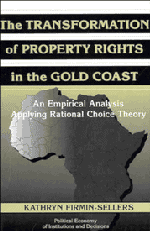 The Transformation of Property Rights in the Gold Coast
The Transformation of Property Rights in the Gold Coast Book contents
- Frontmatter
- Contents
- Series editor' preface
- Preface
- Acknowledgments
- Chapter 1 Introduction
- PART I THE INSTITUTIONS OF THE COLONIAL STATE
- PART II THE REINVENTION OF TRADITION: THE EVOLUTION OF PROPERTY RIGHTS UNDER INDIRECT RULE
- PART III THE TRANSITION TO INDEPENDENT GOVERNMENT
- Chapter 5 Redefining the institutions of central government: The writing of the Coussey Constitution
- Chapter 6 The return to the traditional state
- Chapter 7 Conclusion
- Notes
- Bibliography
- Index
Chapter 6 - The return to the traditional state
Published online by Cambridge University Press: 08 January 2010
- Frontmatter
- Contents
- Series editor' preface
- Preface
- Acknowledgments
- Chapter 1 Introduction
- PART I THE INSTITUTIONS OF THE COLONIAL STATE
- PART II THE REINVENTION OF TRADITION: THE EVOLUTION OF PROPERTY RIGHTS UNDER INDIRECT RULE
- PART III THE TRANSITION TO INDEPENDENT GOVERNMENT
- Chapter 5 Redefining the institutions of central government: The writing of the Coussey Constitution
- Chapter 6 The return to the traditional state
- Chapter 7 Conclusion
- Notes
- Bibliography
- Index
Summary
The passage of the Coussey Constitution marked the first in a series of constitutional reforms that would culminate in Gold Coast independence in 1957. With each change, indigenous politicians gained greater responsibility over domestic affairs. By 1954, indigenous politicians exercised most powers of internal self-government; and in 1957, they gained control over matters concerning internal security and external defense. Prior to 1957, however, indigenous actors did not wield coercive authority themselves, and therefore remained dependent on the British to enforce (implicitly or explicitly) their policy decisions.
The changes in the constitutional framework profoundly altered the battle to define property rights in the Gold Coast. Nkrumah used the instruments of central government to redefine property rights. On behalf of his constituency, he claimed for the state land, mineral resources, and even the profits from some individual investments.
The Gold Coast elite resisted the redefinition of property rights and the concomitant redistribution of wealth. In the face of a hostile central government, the elite sought to vest the power to define and enforce property rights in the traditional state. To this end, they launched a campaign to bolster traditional institutions and traditional rulers, placing them at the center of political life; and to redraft the constitution, decentralizing authority so that the central government might not intervene in local affairs.
- Type
- Chapter
- Information
- The Transformation of Property Rights in the Gold CoastAn Empirical Study Applying Rational Choice Theory, pp. 114 - 143Publisher: Cambridge University PressPrint publication year: 1996


